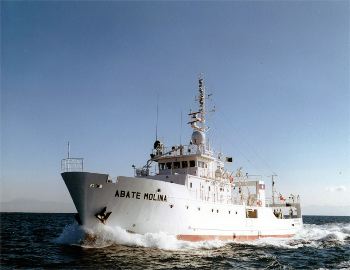
Scientific vessel, Abate Molina. (Photo: IFOP)
Since 11 March, 24 professionals from the Fisheries Development Institute (IFOP) have been aboard the research vessel (B/C) Abate Molina to start a survey that will quantify horse mackerel biomass.
The scientific team left the port of Valparaiso (Valparaíso Region) and will operate between the regions of Arica and Parinacota as well as that of Coquimbo.
Specifically, between Arica (18˚25' LS) and the island Chañaral (29˚15' LS) and from 1 to 100 miles offshore.
According to IFOP, the researchers will use hydroacoustic methods to quantify the biomass of the pelagic resource.
The project leader is Jose Cordova, fishing engineer; and the captain of the boat is Ivan Giakoni.
This new research cruise will last for 39 days.
IFOP explained that the specific objectives of the project are:
- To estimate the abundance and biomass of horse mackerel;
- To set composition of height, weight, age and gender ratio of the horse mackerel stock in the area and study period;
- To determine the composition of major food items of horse mackerel;
- To define the horse mackerel spatial location and bathymetric situation as well as distribution of zooplankton;
- To specify bycatch and its relative importance in sets of identification.
As the cruise ends, a document describing the progress and including the preliminary results of the estimated biomass of horse mackerel and a distribution letter in the study area will be delivered.
After five days of intense negotiations among member countries and cooperating nations for the Third Committee of the South Pacific Regional Fisheries Management Organisation(SPRFMO), held in February in Auckland (New Zealand), Chile managed to obtain 297,000 tonnes for the extraction of horse mackerel both in its territorial waters and offshore during 2015.
This allocation means 7,000 tonnes more over the year 2014.
In the allocation, Chile was followed by China, which received 29,200 tonnes, and the European Union, which was given 28,100 tonnes.
With these figures, Chile reaffirmed its dominant share of the horse mackerel resource and the capture activity is projected for the industrial, artisanal and processing sectors with stability for the rest of the year.
